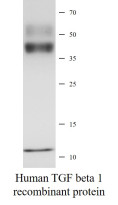ARG70477
Human TGF beta 1 recombinant protein (Active) (His-tagged, N-ter)
Human TGF beta 1 recombinant protein (Active) (His-tagged, N-ter) for SDS-PAGE
Overview
| Product Description | HEK293 expressed, His-tagged (N-ter) Active Human TGF beta 1 recombinant protein |
|---|---|
| Tested Application | SDS-PAGE |
| Target Name | TGF beta 1 |
| Species | Human |
| A.A. Sequence | Met1 - Ser390 |
| Expression System | HEK293 |
| Activity | Active |
| Activity Note | Determined by its s ability to inhibit the IL-4 dependent proliferation in TF-1 cells. The ED50 for this effect is < 0.1 ng/mL |
| Alternate Names | TGFB; DPD1; TGFbeta; CED; Transforming growth factor beta-1; LAP; TGF-beta-1 |
Properties
| Form | Powder |
|---|---|
| Purification Note | Endotoxin level is less than 0.1 EU/µg of the protein, as determined by the LAL test. |
| Purity | > 95% (by SDS-PAGE) |
| Buffer | PBS (pH 7.0) |
| Reconstitution | It is recommended to reconstitute the lyophilized protein in sterile water to a concentration not less than 200 μg/mL and incubate the stock solution for at least 20 min at room temperature to make sure the protein is dissolved completely. In some experiments, it recommends to add 10 mM HCl when reconstitute lyophilized protein. |
| Storage Instruction | For long term, lyophilized protein should be stored at -20°C or -80°C. After reconstitution, aliquot and store at -20°C or -80°C for up to one month. Storage in frost free freezers is not recommended. Avoid repeated freeze/thaw cycles. Suggest spin the vial prior to opening. |
| Note | For laboratory research only, not for drug, diagnostic or other use. |
Bioinformation
| Gene Symbol | TGFB1 |
|---|---|
| Gene Full Name | transforming growth factor, beta 1 |
| Background | This gene encodes a member of the transforming growth factor beta (TGFB) family of cytokines, which are multifunctional peptides that regulate proliferation, differentiation, adhesion, migration, and other functions in many cell types. Many cells have TGFB receptors, and the protein positively and negatively regulates many other growth factors. The secreted protein is cleaved into a latency-associated peptide (LAP) and a mature TGFB1 peptide, and is found in either a latent form composed of a TGFB1 homodimer, a LAP homodimer, and a latent TGFB1-binding protein, or in an active form composed of a TGFB1 homodimer. The mature peptide may also form heterodimers with other TGFB family members. This gene is frequently upregulated in tumor cells, and mutations in this gene result in Camurati-Engelmann disease.[provided by RefSeq, Oct 2009] |
| Function | Multifunctional protein that controls proliferation, differentiation and other functions in many cell types. Many cells synthesize TGFB1 and have specific receptors for it. It positively and negatively regulates many other growth factors. It plays an important role in bone remodeling as it is a potent stimulator of osteoblastic bone formation, causing chemotaxis, proliferation and differentiation in committed osteoblasts. Can promote either T-helper 17 cells (Th17) or regulatory T-cells (Treg) lineage differentiation in a concentration-dependent manner. At high concentrations, leads to FOXP3-mediated suppression of RORC and down-regulation of IL-17 expression, favoring Treg cell development. At low concentrations in concert with IL-6 and IL-21, leads to expression of the IL-17 and IL-23 receptors, favoring differentiation to Th17 cells. [UniProt] |
| Cellular Localization | Secreted, extracellular space, extracellular matrix. [UniProt] |
| PTM | Glycosylated. The precursor is cleaved into mature TGF-beta-1 and LAP, which remains non-covalently linked to mature TGF-beta-1 rendering it inactive. [UniProt] |
Images (1) Click the Picture to Zoom In






